|
(Redirected from Technical University of Berlin)
| Berlin Institute of Technology |
| Technische Universität Berlin |
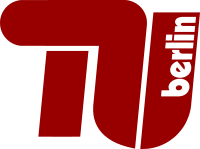 |
| 校训 |
Wir haben die Ideen für die Zukunft |
| 建立于 |
1770/1799/1879
1946 |
| 类型 |
Public University |
| 捐赠 |
State: EUR 267,2 Mio. (2007)
External: EUR 78,0 Mio (2006) |
| 校长 |
Prof. Dr.-Ing. Joerg Steinbach (since 01.April 2010) |
| 工作人员 |
7,499 (WS 2009/10) |
| 学生 |
29,234 (WS 2009/10) |
| 位置 |
Berlin,  Germany Germany
52°30′43″N 13°19′35″E / 52.51194°N 13.32639°E / 52.51194; 13.32639Coordinates: 52°30′43″N 13°19′35″E / 52.51194°N 13.32639°E / 52.51194; 13.32639 |
| 校园 |
Urban |
| Nobel Laureates |
8 |
| 归属 |
TIME, TU9, CESAER, DFG, SEFI |
| 网址 |
www.tu-berlin.de |
|
|
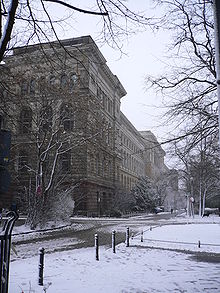
South side of the main building (in winter)
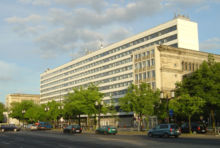
Main building (in summer)
The Berlin Institute of Technology (Technical University of Berlin, TUB, TU Berlin, German: Technische Universität Berlin) is a research university located in Berlin, Germany. It was founded in 1879 and, with nearly 30,000 students, is one of the largest technical universities in Germany. It also has the highest proportion of foreign students out of universities in Germany, with 20.9% in the summer semester of 2007, roughly 5,598 students. The university alumni and professor list include eight Nobel Prize winners.
The TU Berlin is a member of Top Industrial Managers for Europe network, which allows for student exchanges between leading European engineering schools. It also belongs to Conference of European Schools for Advanced Engineering Education and Research (CESAER). TU Berlin is ranked 62nd in the world in the field of Engineering/Technology according to Times Higher Education-QS World University Rankings.
历史
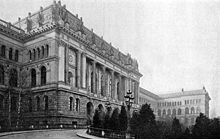
The old northern front of the main building, which was considerably damaged during the Second World War and replaced by a modern front in the 1960s
The institution was unified in 1879 under the name Royal Technical College of Charlottenburg (later Berlin) by merging the Building Academy (Bauakademie), established in 1799, and the Vocational Academy, established in 1829. Since 1916 it has been integrated with the former Mining Academy, which was the oldest institution, founded in 1770. The college was closed after World War II on April 20, 1945 and the university re-opened on April 9, 1946 under its current name.
校园
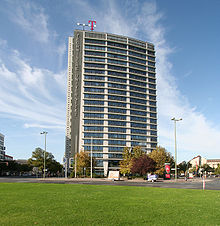
TU-Hochhaus, the tallest building on campus, with a bird's-eye-view cafeteria on floor 20.
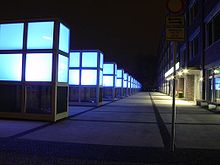
Entrance of the main library of the Technical University of Berlin and of the Berlin University of the Arts
The TU Berlin covers ca. 600,000 m², distributed over various locations in Berlin. The main campus is located in the borough of Charlottenburg. The seven schools of the university have some 28,200 students enrolled in more than 50 subjects (January, 2009).
组织
Since April 4, 2005, the TU Berlin has consisted of the following schools:
- Humanities
- Mathematics and Natural Sciences
- Process Sciences and Engineering
- Electrical Engineering and Computer Science
- Mechanical Engineering and Transport Systems (including Aerospace engineering, Automotive engineering, naval and ocean engineering, and the planning and operation of transport systems)
- Planning - Building - Environment (merge of former schools of "Civil Engineering and Applied Geosciences" and "Architecture - Environment - Society")
- Economics and Management
Faculty and staff
7,601 people work at the university: 323 professors, 2,246 postgraduate researchers, and 2,078 personnel work in administration, the workshops, the library and the central facilities. In addition there are 2,301 student assistants and 142 trainees (March 2010).
International student mobility is applicable through ERASMUS programme or through Top Industrial Managers for Europe (TIME) network.
Library
The new common main library of the Technical University of Berlin and of the Berlin University of the Arts was opened in 2004 and holds about 2.9 million volumes (2007). The library building was sponsored partially (estimated 10% of the building costs) by Volkswagen and is named officially "University Library of the TU Berlin and UdK (in the Volkswagen building)". Confusingly, the letters above the main entrance only state "Volkswagen Library" - without any mentioning of the universities. All former 17 libraries of the Technical University of Berlin and of the nearby University of the Arts were merged into the new library, but several departments still retain libraries of their own. In particular, the school of 'Economics and Management' maintains a library with 340,000 volumes in the university's main building (Wirtschaftswissentschaftliche Dokumentation – WiWiDok).
Notable alumni and professors
See also: :Category:Technical University of Berlin alumni
See also: :Category:Technical University of Berlin faculty
(Including those of the Academies mentioned under History)
- August Borsig, businessman
- Carl Bosch (1874–1940), chemist, Nobel prize winner 1931
- Wernher von Braun (1912–1976), head of Nazi Germany's V-2 rocket program, saved from prosecution at the Nuremberg Trials by Operation Paperclip, first director of the United States National Aeronautics and Space Administration's (NASA) Marshall Space Flight Center, called the father of the U.S. space program
- Krafft Arnold Ehricke(1917 - 1984), rocket-propulsion engineer, worked for the NASA, chief designer of the D-1 Centaur, the world's first upper-stage-booster that used liquid hydrogen and oxygen.
- Klaus Riedel( 1907 - 1944), german rocket pioneer, worked on the V-2 missile programme at Peenemünde.
- Arthur Rudolph(1906 – 1996) worked for the U.S. Army and NASA, developer of Pershing missile and the Saturn V Moon rocket.
- Walter Dornberger (1895 - 1980), developer of the Air Force-NASA X-20 Dyna-Soar project.
- Wigbert Fehse (*1937) german engineer and researcher in the area of automatic space navigation, guidance, control and docking/berthing.
- Fritz Gosslau(1898 – 1965), german engineer, known for his work at the V-1 flying bomb.
- Fritz Houtermans (1903 – 1966) atomic and nuclear physicist, Nobel Prize laureate (1925)
- Hugo Junkers (1859 – 1935), former of Junkers & Co, a major German aircraft manufacturer.
- Walter Kaufmann(1871 - 1947), physicist, well-known for his first experimental proof of the velocity dependence of mass.
- Philipp Mißfelder(*1979), german politician
- Ida Noddack(1896 - 1978), nominated three times for Nobel Prize in Chemistry.
- Georg Hans Madelung(1889 -1972), a German academic and aeronautical engineer.
- Franz Breisig (1868–1934), mathematician, inventor of the calibration wire and father of the term quadripole network in electrical engineering
- Wilhelm Cauer (1900-1945), mathematician, essential contributions to the design of filters
- Carl Dahlhaus (1928-1989), musicologist
- Dennis Gabor (1900–1971), physicist (holography), Nobel prize winner 1971
- Fritz Haber (1868–1934), chemist, Nobel prize winner 1918
- Sabine Hark (born 7. August 1962), sociologist and professor of gender studies
- Gustav Ludwig Hertz (1887–1975), physicist, Nobel prize winner 1925
- George de Hevesy (1885–1966), chemist, Nobel prize winner 1943
- Karl Küpfmüller (1897–1977), electrical engineer, essential contributions to system theory
- Wassili Luckhardt (1889–1972), architect
- Alexander Meissner (1883–1958), electrical engineer
- Ivan Stranski (1897–1979), chemist, considered the father of crystal growth research
- Adolf Slaby (1849-1913), german wireless pioneer
- Alois Riedler (1850-1936), vigorous proponent of practically-oriented engineering education
- Erwin Wilhelm Müller (1911–1977), physicist (field emission microscope, field ion microscope, atom probe)
- Jakob Karol Parnas (1884–1949), biochemist, Embden-Meyerhof-Parnas pathway
- Wolfgang Paul (1913–1993), physicist, Nobel prize winner 1989
- Ernst Ruska (1906–1988), physicist (electron microscope), Nobel prize winner 1986
- Karl Friedrich Schinkel (1781-1841), architect (at the predecessor Berlin Building Academy)
- Georg Schlesinger (1874–1949)
- Franz Reuleaux (1829–1905), mechanical engineer, often called the father of kinematics
- Albert Speer (1905–1981), architect, politician, Minister for Armaments during the Third Reich, war criminal
- Kurt Tank (1893–1983), head of design department of Focke-Wulf, designed the FW-190
- Wilhelm Heinrich Westphal (1882–1978), physicist
- Günter M. Ziegler (*1963), Gottfried Wilhelm Leibniz Prize (2001)
- Hermann W. Vogel, (1834–1898) photo-chemist
- Eugene Wigner (1902–1995), physicist, discovered the Wigner-Ville-distribution, Nobel prize winner 1963
- Konrad Zuse (1910–1995), computer pioneer
更多
Other Universities of Berlin:
- Berlin School of Economics and Law
- Freie Universität Berlin (Free University of Berlin)
- Hertie School of Governance
- Humboldt Universität zu Berlin (Humboldt University of Berlin)
- Universität der Künste (Berlin University of the Arts)
Rankings
Top Study Links University Rankings 2010 ranks Technische Universität Berlin as the 7 best university in Germany. The university is ranked 137 in the World.
参考文献
- ^ http://www.tu-berlin.de/menue/ueber_die_tu_berlin/zahlen_fakten/#4932
- ^ http://www.tu-berlin.de/menue/ueber_die_tu_berlin/zahlen_fakten/#4932
- ^ http://www.tu-berlin.de/menue/ueber_die_tu_berlin/zahlen_fakten/#4931
- ^ http://www.tu-berlin.de/menue/ueber_die_tu_berlin/zahlen_fakten/#91200
- ^ http://nobelprize.org/nobel_prizes/physics/laureates/1925/hertz-bio.html
- ^ http://nobelprize.org/nobel_prizes/chemistry/laureates/1943/hevesy-bio.html
- ^ http://nobelprize.org/nobel_prizes/chemistry/laureates/1918/haber-bio.html
- ^ http://nobelprize.org/nobel_prizes/physics/laureates/1925/hertz-bio.html
- ^ http://nobelprize.org/nobel_prizes/chemistry/laureates/1931/bosch-bio.html
- ^ http://nobelprize.org/nobel_prizes/chemistry/laureates/1918/haber-bio.html
- ^ https://www.time-association.org/members/
- ^ http://www.cesaer.org/en/members/germany/
- ^ http://www.topuniversities.com/university-rankings/world-university-rankings/2009/subject-rankings/technology
- ^ http://www.tu-berlin.de/menue/ueber_die_tu_berlin/zahlen_fakten/parameter/en/
- ^ http://www.tu-berlin.de/menue/ueber_die_tu_berlin/zahlen_fakten/parameter/en/#17815
- ^ http://www.ub.tu-berlin.de/index.php?id=555#content10219
- ^ http://www.ub.tu-berlin.de/index.php?id=555#content2195
- ^ http://www.ub.tu-berlin.de/
- ^ http://topstudylinks.com/Top-Universities-in-Germany-c178.aspx
External links
- (German) Official Homepage
- (English) Official Homepage
- (German) Homepage of the Student's Council and Government
- Map of campus
|
|



